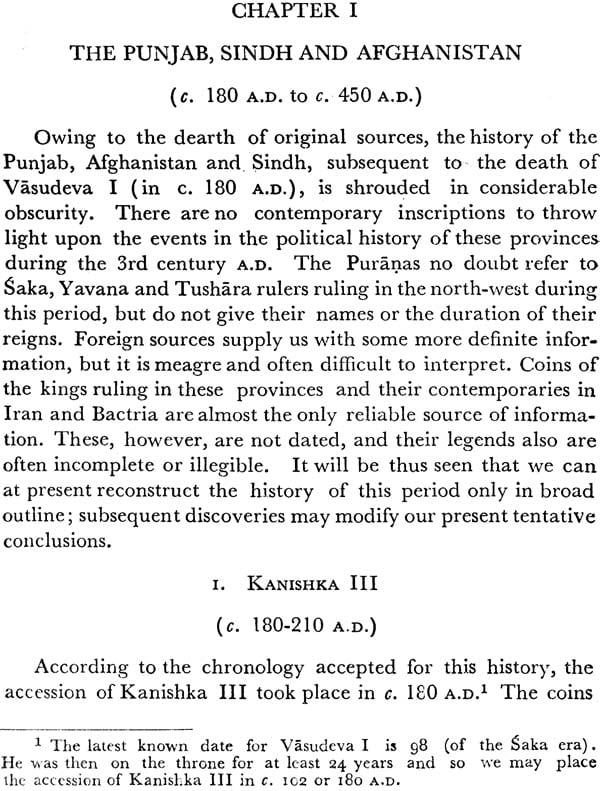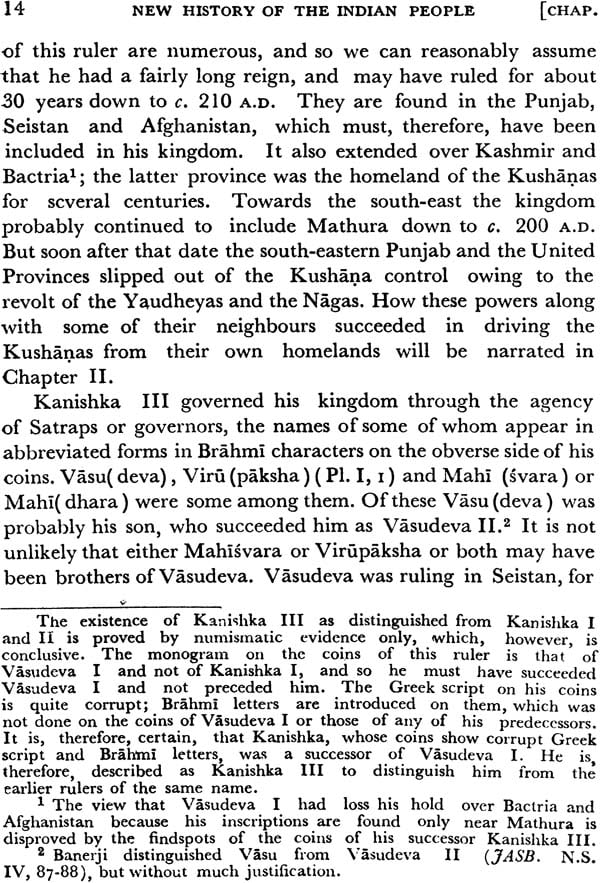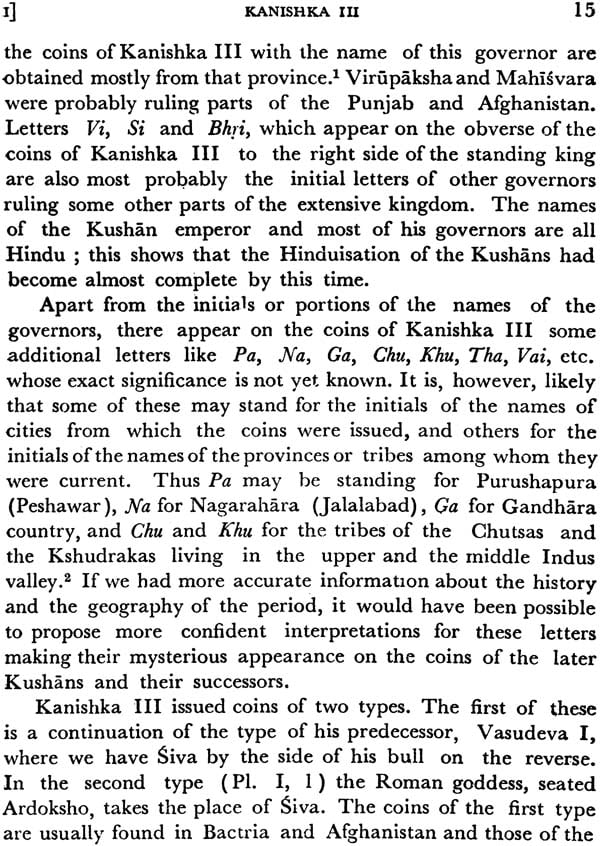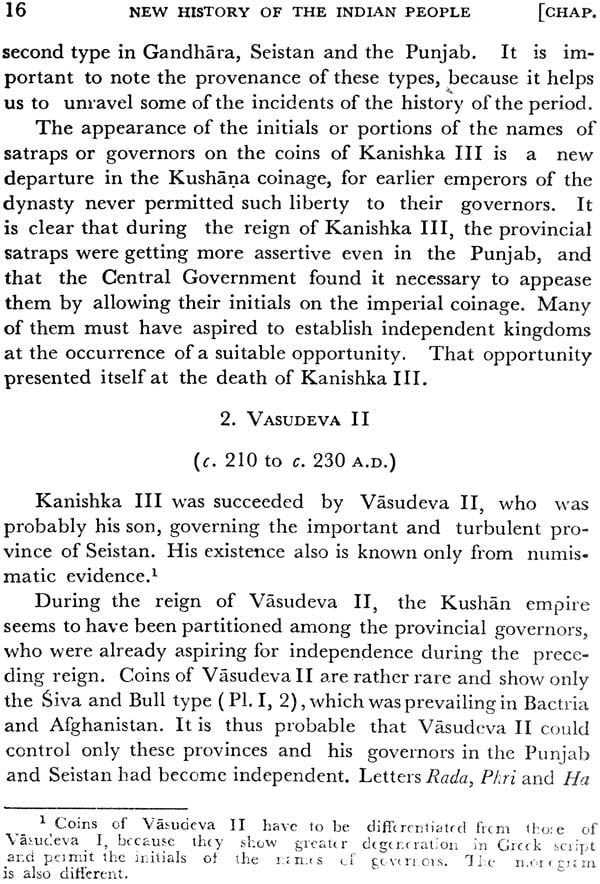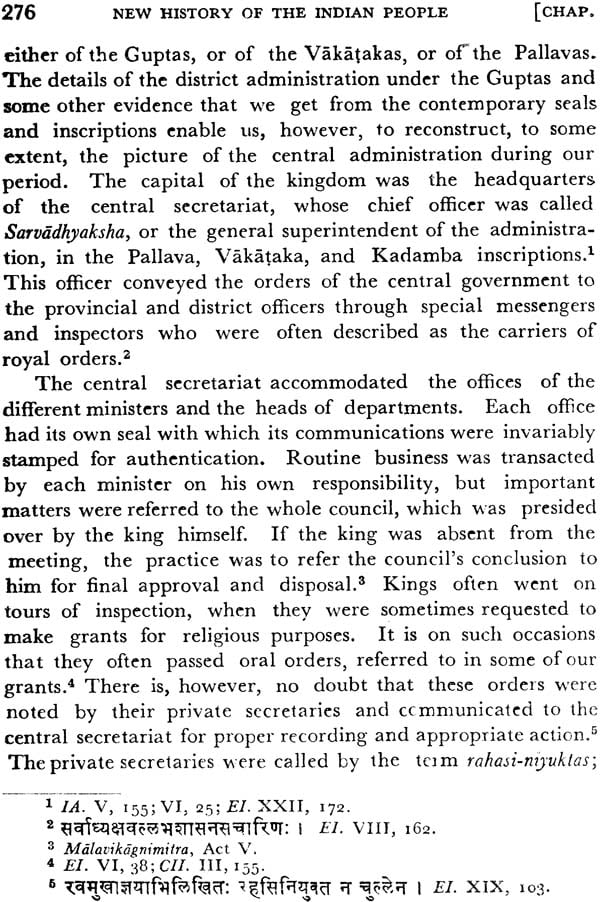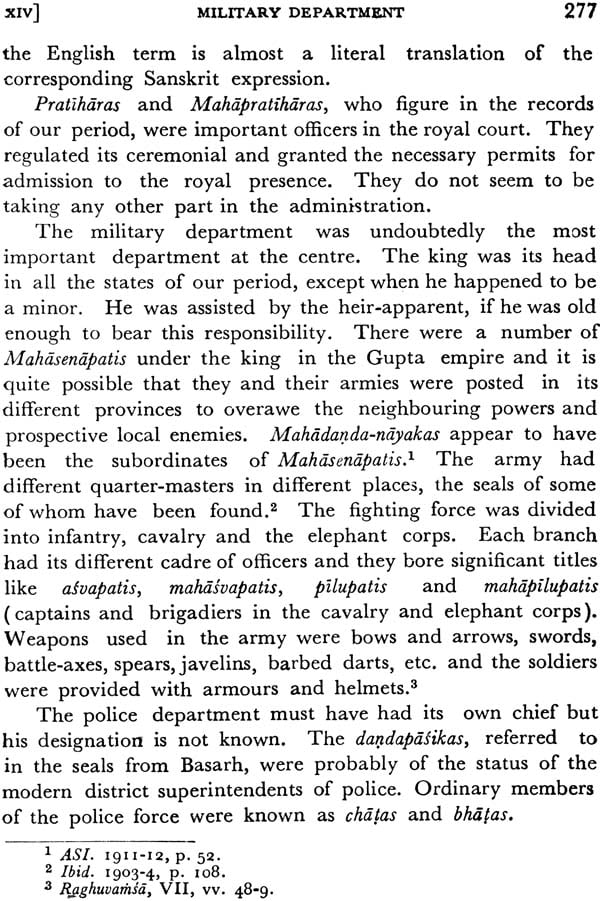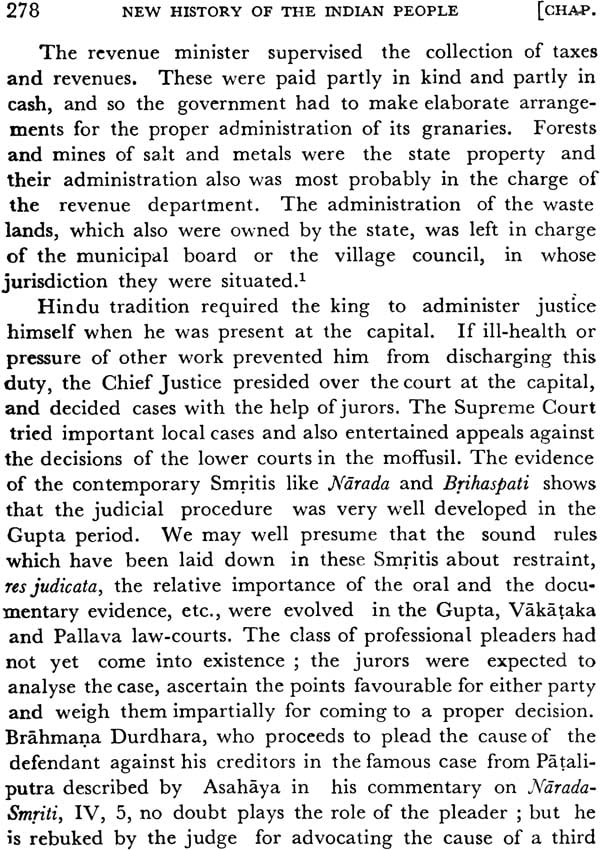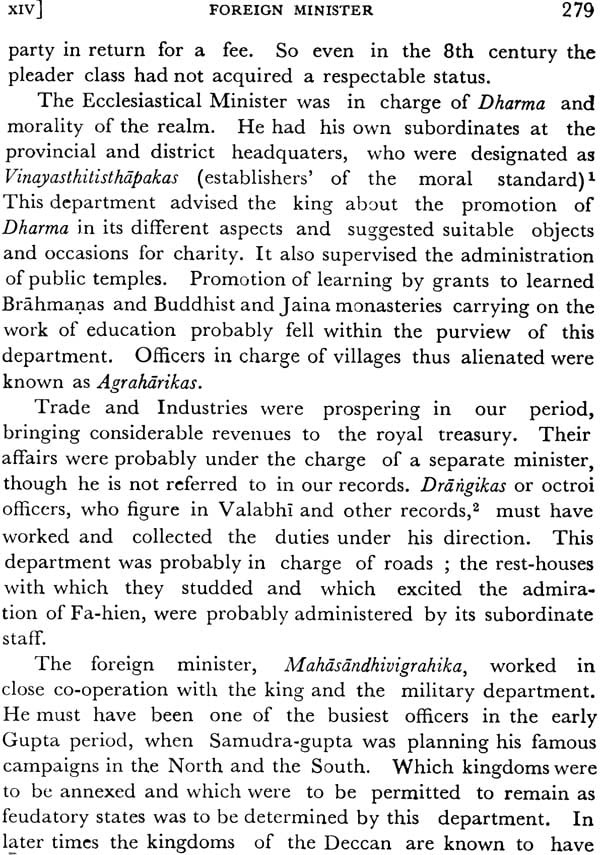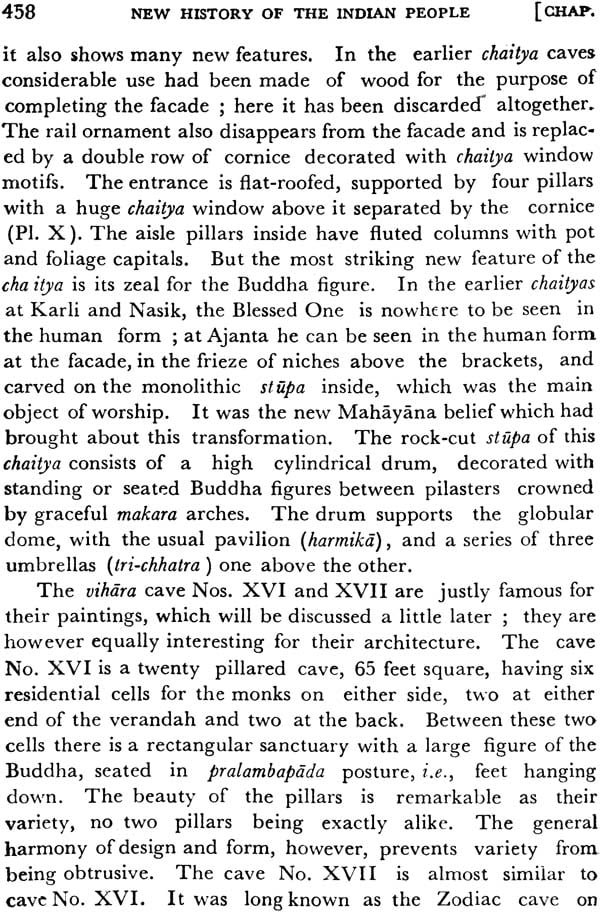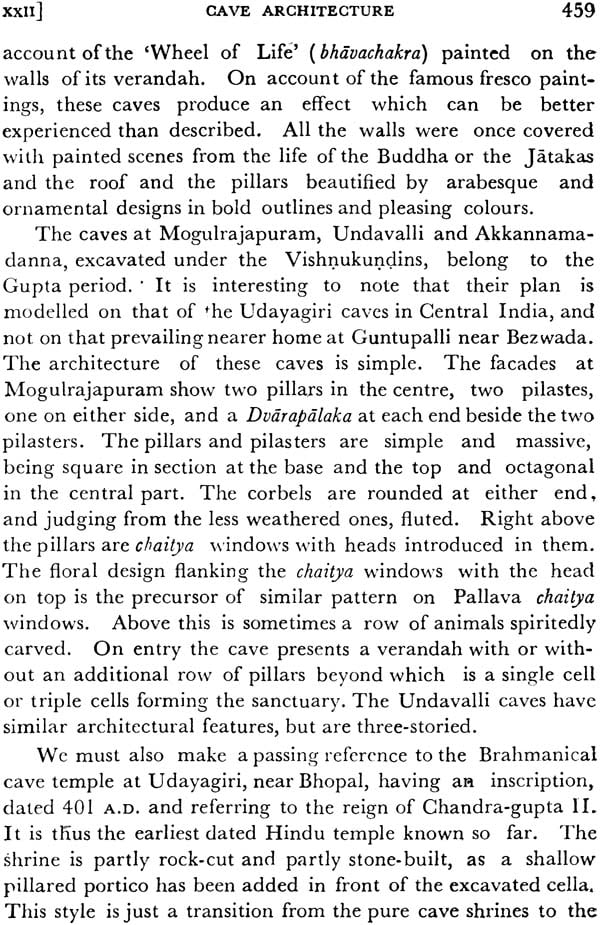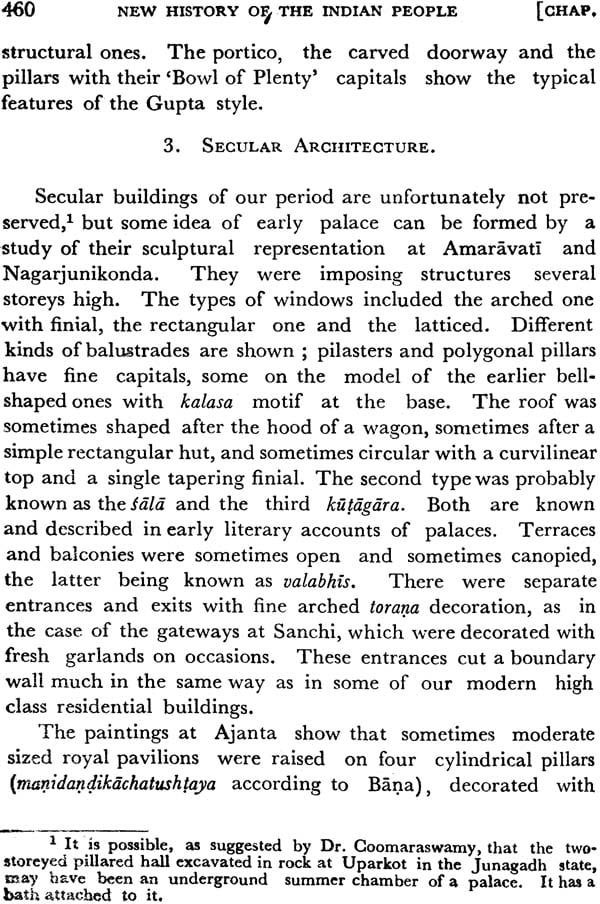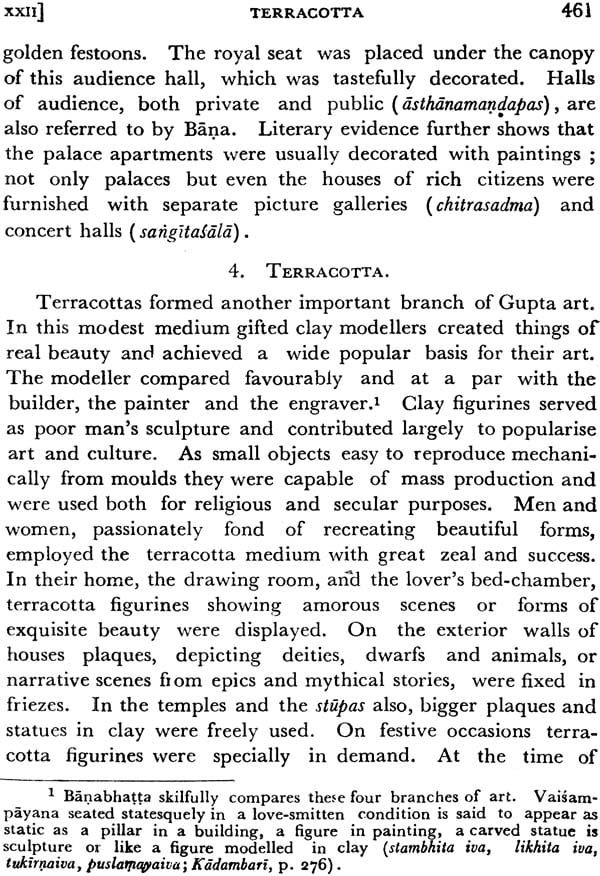
The Vakataka-Gupta Age
Book Specification
| Item Code: | IDK441 |
| Author: | R.C. Majumdar and A.S. Altekar |
| Publisher: | MOTILAL BANARSIDASS PUBLISHERS PVT. LTD. |
| Language: | English |
| Edition: | 2007 |
| ISBN: | 9788120800434 |
| Pages: | 558 (15 B/W Illustrations) |
| Cover: | Paperback |
| Other Details | 7.0" X 4.8" |
| Weight | 520 gm |
Book Description
Foreword
In the middle of the 19th Century all the parts of India were united under one sceptre, and then began a change, almost revolutionary in its character, in the evolution of India's political life and thought. At exactly the same time a revolution also began in Indian historiography. Hitherto our historians' stock-in-trade had been only pious legends, age-worn traditions, laudatory poems in hyperbole, and very late compilations of blended fact and fiction. The Hindu period of our past, covering nearly two thousand years was dark, and the darkness was often made more misleading by the false light of Sanskrit romances. Even in the Muslim period the current histories were mostly popular abridgements and not original sources.
But a new era in the study of Indian history had dawned shortly before the Sepoy Mutiny. General Alexander Cunningham had begun to dig down to the roots of our Buddhistic, Jaina and Hindu past, and Sir Henry M. Elliot had begun the monumental translation of the History of India as told by its own historians. His great work, destined to be completed in a vastly amplified form and by another hand in eight volumes in 1877, made its first appearance in 1849 under the title of Bibliographical Index to the Historians of Muhammadan India. The first author to utilize the vast material, thus made available in English, was Stanley Lane-Poole, whose Mediaeval India under Muhammadan Rule (1903), when read with Elphinstone's chapters on the same subject, illustrates the advance in our knowledge made in less than half a century.
In the Hindu period, the immense mass of raw materials, in the form of inscriptions, coins, architectural remains and antiquities, brought to light by our field archaeologists-both official and private, scattered all over this continent of a country, was pieced together for the first time in V.A. Smith's Early History of India (1904). Indian reader had, no doubt, had an earlier glimpse of this new material, though in a very compressed form, in Hara Prasad Shastri's School History of India. But Smith's work, occupying a much ampler canvas and full of details and exact references, can rightly claim to be called an epoch-marking book.
But our progress did not stop here. An army of Indian scholars, some trained, but most others amateurs, continued Cunningham's work in their own localities or subjected the discoveries of others to critical study, and thus built up a vast body of more exact knowledge about our past than was available to Vincent A. Smith. All this knowledge lies scattered over numberless learned journals, popular magazines, sometimes even daily papers, pamphlets and books, in many languages besides English. Our problem for several years now has been to concentrate all these scattered rays of light into one focus, to make a synthesis of all over special treatises and researches our scientific students, "We have plenty of spinners, who have produced fine threads. We now want a master weaver who will synthetise all these isolated facts. That the crying need of the modern world of science: weave! Weave!"
A new History of India embodying all this accumulated knowledge and abreast of the latest research must fill many volumes. Such a work, both by reason of its size and the diversity of its contents, can be produced only by a syndicate of scholars. The writing of such a co-operative History of India was first discu8ssed by me with the late Mano Mohan Chakravarti in 1908 after the first volumes of the Cambridge Modern History had come out and shown us the way. The plan was discussed in great detail and even lists of chapters drawn up on two occasions in collaboration with the late Rakhaldas Banerji in 1918 and 1920. a fourth project, confined solely to the cultural aspects of India's past on the model of the "Heritage" series, was pondered over by me with the late Rev. J. Farquhar. But all of these schemes very soon came to nothing because we felt that the time was not yet ripe and we had not enough scholars to do equal justice to every part of the subject.
At last in 1937, Dr. Rajendra Prasad publicly broached the present scheme and we two inaugurated it at a meeting held in Benares on 28th December, 1937. He was to take charge of the administrative and financial side of it, and I was to be the chief literary manager or chairman of the Editorial Board. Prompt and generous donations were received from the Indian mercantile community whose liberality to all good causes is well-known : and we actively set ourselves to planning the details, making the preliminary arrangements and corresponding with various scholars whose aid or advice we sought. Just after the actual writing had started, came the Japanese invasion in 1941, and our scholars were scattered and public libraries closed or removed elsewhere, which made us lose four years. At last in 1945, two volumes (the Fourth and the Sixth) out of a projected series of twenty (see the list at the end) were ready for the press and a third (the Twelfth, on Akbar) half completed. Now that the ground has been fully prepared, our progress both in writing and in printing will be much quicker.
It has been my dream to produce them volumes at a price (say Rs. 4 each) which would place them within reach of all our people, as the volumes would be sold separately. With the knowledge of our land's storied past daily advancing, revised editions would be frequently called for, in order that this science may not be stereotyped; but a low price would enable most purchasers of the old edition to scrap it up and buy its improved and corrected successor. But the economic disturbance caused by World War II has belied this hope.
This History is being written entirely by Indians. Lest this limitation of choice should cause its spirit to be suspect I invite the reader's attention to the following correspondence which makes our aim fully clear.
From Sir Jadunath Sarkar to Dr. Rajendra Prasad, 19th November, 1937-"National history, like every other history worthy of the name and deserving to endure, must be true as regards the facts and reasonable in the interpretation of them, it will be national not in the sense that it will try to suppress or whitewash everything in our country's past that is disgraceful, but because it will admit them and at the same time point out that there were other and nobler aspects in the stages of our nations' evolution which offset the former, that a "drain inspector's report" is not the whole truth about any nation. The first duty of our national historian will be to depict all the aspects of our nation's life in the past usually ignored by foreign writers, who merely give us an unrelieved picture of bloodshed and dynastic change. Social life and thought, art and culture, will have no less importance in the history to be written by us. In addition, we shall try to explain, with that sympathetic insight which only a native can possess,-or a rare foreigner like the gifted Sister Nivedita,-why things happened with our ancestors as they did actually happen. In this task .the historian must be a judge. He will not suppress any defect of the national character, but add to his portraiture those higher qualities which, taken together with the former, help to constitute the entire individual."
From Dr. Rajendra Prasad to Sir Jadunath Sarkar, 22nd November, 1937-"I entirely agree with you that no history is worthy the name which suppresses or distorts facts. A historian who purposely does so under the impression that he thereby does good to his native country really harms it in the end Much more so in the case of a country like ours which has suffered much on account of its national defects, and which must know and understand them to be able to remedy them."
Our thanks are specially due to Dr. Ramesh Chandra Majumdar and Dr. A.S. Altekar, who have edited this volume and written most part of it, Dr. Majumdar contributing eight chapters and Dr. Altekar ten out of a total of 23. We have been fortunate enough to enlist the co-operation of a number of other scholars, each eminent in his special subject: Rao Bahadur K.N. Dikshit has written on Archaeological Remains, Prof. K.A. Nilkant Sastri on South India, Dr. Dines Chandra Sircar on the Eastern Deccan, Dr. P.G. Bagchi on Chinese Contact, Dr. Paranavitana on Ceylon, Dr. C. Sivarama-murti on South Indian Art, and Dr. V.S. Agrawala on Gupta Art. We offer our sincere thanks to all of them and also to the Director-General of Archaeology, Government of India, the authorities of the Nizam's Archaeological Department and the Mathura Museum for permission to print illustrations of which they hold the copyright.
WE also take this opportunity to thank Mr. S. K. Sarasvati, M.A., Lecturer, Calcutta University, who has helped the editors in seeing the book through the press and has rendered very useful service in many ways. Our thanks are also due to the Sri Gouranga Press for having undertaken the printing of this book in a time of exceptional difficulty and executed it with commendable promptitude.
| Foreword, by Sir Jadunath Sarkar, Kt., C.I.E., Hon. D. Litt., Hony. M.R.A.S. | i | |
| Editorial Preface | x | |
| Introduction, by Dr. A.S. Altekar, M.A., D.Litt. Manindra Chandra Nandi Professor and Head of the Department of Ancient Indian History and Culture, Hindu University, Benares | I | |
| Ancient Indian History and Culture, Hindu University, Benares | 1 | |
| THE PUNJAB, SINDH AND AFGHANISTAN By Dr. A.S. Altekar | ||
| 1 | Kanishka III | 13 |
| 2 | Vasudeva II | 16 |
| 3 | The Period of Sassanian Ascendancy | 18 |
| 4 | The Punjab during c. 230 to c. 340 A.D. | 21 |
| 5 | The Kidara Kushanas | 21 |
| NEW INDIAN STATES IN RAJPUTANA AND MADHYADESA By Dr. A.S. Altekar | ||
| 1 | Did the Bharasivas drive out the Kushanas? | 25 |
| 2 | The Yaudheya, Kuninda and Arjunayana Republics | 28 |
| 3 | The Madra Republic | 33 |
| 4 | The Malava Republic | 33 |
| 5 | The Nagas of Padmavati and Mathura | 36 |
| 6 | The Maukharis of Badva | 40 |
| 7 | The Maghas of Baghelkhand and Kausambi | 41 |
| THE SAKA RULERS OF WESTERN INDIA By Dr. A. S. Altekar | ||
| 1 | Damajada I, Jiva-daman and Rudra-simha I | 47 |
| 2 | Rudra-sena | 49 |
| 3 | Sangha-daman and Dama-sena | 52 |
| 4 | Yaso-daman, Vijaya-sena Damajada II and Rudra-sena II | 53 |
| 5 | Visva-simha and Bhartri-daman | 55 |
| 6 | The Rise of a New Saka House: Rudra-simha II and Yaso-daman II | 57 |
| 7 | Rudra-daman II and his Successors | 60 |
| EASTERN DECCAN By Dr. Dines Chandra Sircar, M.A., Ph.D. Lecturer, Ancient Indian History and Culture, Calcutta University | ||
| I. | Andhra | 64 |
| The Ikshvakus | 64 | |
| The Brihatphalayanas | 68 | |
| The Anandas | 69 | |
| The Salankayanas | 73 | |
| 2. | Kalinga | 76 |
| The Pitribhaktas | 77 | |
| The Matharas | 79 | |
| The Vasishthas | 80 | |
| Other Dynasties | 81 | |
| 3. | Kosala (Dakshina Kosala) and Mekala | 84 |
| The Sarabhapuriyas | 86 | |
| The Pandduvamsis | 89 | |
| THE VAKATAKAS By Dr, A.S. Altekar | ||
| 1. | The Deccan at c. 250 A.D. | 93 |
| 2. | Vakataka Chronology | 94 |
| 3. | The Home of the Vakatakas | 96 |
| 4. | Vindhyasakti | 96 |
| 5. | Emperor Pravara-sena I | 98 |
| 6. | Rudra-sena I | 102 |
| 7. | Prithvi-shena I | 108 |
| 8. | Rudra-sena II | 110 |
| 9. | Regency of Prabhavati-gupta | 111 |
| 10. | Pravara-sena II | 113 |
| 11. | Narendra-sena | 115 |
| 12. | Prithvi-shena II | 118 |
| 13. | Basim Branch of the Vakatakas | 119 |
| 14. | The Full of the Vakatakas | 123 |
| THE RISE OF THE GUPTAS By Dr. R.C. Majumdar, M.A., Ph. D., F.R.A.S.B., Formerly Vice-Chancellor, Dacca University | 126 | |
| Appendix-The Extent of the Kingdom of Chandra-gupta I | 134 | |
| FOUNDATION OF THE GUPTA EMPIRE By Dr. R. C. Majumdar | ||
| 1. | Sources of history | 136 |
| 2. | Samudra-gupta's Accession | 137 |
| 3. | Samudra-gupta's Conquests | 139 |
| 4. | Personality of Samudra-gupta | 154 |
| THE EXPANSION OF THE GUPTA EMPIRE By Dr. R. C. Majumdar | ||
| THE IMPERIAL CRISIS By Dr. R. C. Majumdar | ||
| 1. | Internal Troubles | 184 |
| 2. | The Huna Invasion | 193 |
| CHAPTER X THE DISINTEGRATION OF THE GUPTA EMPIRE By Dr. R. C. Majumdar | 202 | |
| THE FALL OF THE GUPTA EMPIRE By Dr. R. C. Majumdar | 213 | |
| SOUTH INDIA By Prof. K. A. Nilakanta Sastri, M.A., Professor of Indian History, Madras University | ||
| 1. | The Close of the Sangam Age | 219 |
| 2. | The Early Pallavas | 229 |
| 3. | The Kadambas | 235 |
| 4. | The Gangas | 246 |
| HISTORY OF CEYLON By Dr. S. Paranavitana, Ph. D., Archaeological Commissioner, Ceylon | 251 | |
| Appendix-Note on the Chronology | 262 | |
| THE ADMINISTRATIVE ORGANISATION By Dr. A. S. Altekar | ||
| 1. | Republican States | 265 |
| 2. | Monarchical Governments: The Position of the King | 268 |
| 3. | Other Members of the Royal Family | 270 |
| 4. | Powers of the King | 273 |
| 5. | Ministry | 274 |
| 6. | The Machinery and Departments of the Central Government | 275 |
| 7. | The Feudatories | 280 |
| 8. | Kumaramatyas | 281 |
| 9. | Provincial Administration | 283 |
| 10. | The Non-official District Council | 285 |
| 11. | District Administration | 286 |
| 12. | Popular Courts | 288 |
| 13. | Village and Town Administration | 288 |
| 14. | Taxation | 291 |
| 15. | General Review | 292 |
| 16. | CHAPTER XV THE COINAGE By Dr. A. S. Altekar | |
| 1. | The Coinage of the Punjab and Afghanistan | 295 |
| 2. | The Coinage of the Western Kshatrapas | 296 |
| 3. | The Coinage of the Republics | 298 |
| 4. | The Coins of Virasena and Achyuta | 299 |
| 5. | The Naga Coinage | 300 |
| 6. | The Coinage of the Maghas | 300 |
| 7. | No Vakataka Coinage | 301 |
| 8. | The Coinage of the Imperial Guptas | 301 |
| 9. | The Coinage of the Hunas | 305 |
| 10. | Coinage in South India | 306 |
| 11. | Relative values of different coins | 307 |
| COLONIAL AND CULTURAL EXPANSION I. Colonial Expansion in Isnul-India By Dr. R. C. Majumdar | ||
| 1. | Hindu Colonial kingdoms | 309 |
| 2. | Fu-Nan | 310 |
| 3. | Champa | 311 |
| 4. | Other kingdoms | 313 |
| 5. | Hindu Civilisation in Suvarnadvipa | 316 |
| 6. | The Malay Peninsula | 320 |
| II. | Cultural Relations With Eastern Turkestan And China | 323 |
| By Dr. P.C. Bagchi, M.A., Docteur es Letters (Paris), F.R.A.S.B. Director, Cheena Bhavana, Visvabharati, Formerly Lecturer, Calcutta University | ||
| INTERCOURSE WITH THE WESTERN WORLD | 334 | |
| | ||
| SOCIAL AND ECONOMIC CONDITIONS By. Dr. A. S. Altekar I. Social Condition | ||
| I. | Caste System : Inter-marriage | 342 |
| 2. | Caste System : Professions | 343 |
| 3. | Slavery | 348 |
| 4. | The Family | 349 |
| 5. | Food and Drink | 352 |
| 6. | Dress and Ornaments | 353 |
| | ||
| 1. | Guild | 355 |
| 2. | Trade | 357 |
| 3. | Wealth of the Country | 359 |
| 4. | Cost of Living | 359 |
| 5. | Agrarian Problems | 360 |
| RELISION AND PHILOSOPHY By Dr. A.S. Altekar | ||
| 1. | General Background | 363 |
| 2. | The Spirit of Tolerance and Harmony | 364 |
| 3. | Vedic Religion | 368 |
| 4. | Growing Popularity of Puranic Hinduism | 370 |
| 5. | Popular Beliefs | 375 |
| 6. | Rites and Ceremonies | 377 |
| 7. | Hinduism and Foreigners | 378 |
| 8. | Hindu Philosophy | 380 |
| 9. | Buddhism | 382 |
| 10. | Extent of Buddhism | 387 |
| 11. | Jainism | 390 |
| 12. | General View | 394 |
| EDUCATION, LITERATURE AND SCIENCES By Dr. A. S. Altekar | ||
| | 396 | |
| 1. | Agrahara Villages as Centres of Learning | 397 |
| 2. | Rise of Monastic Colleges | 398 |
| 3. | Technical and Primary Education | 400 |
| | 401 | |
| 1. | The Author of the Age : Bhasa | 403 |
| 2. | Kalidasa | 404 |
| 3. | Other Poets | 406 |
| 4. | Fable | 408 |
| 5. | Technical Literature | 409 |
| 6. | Religious and Philosophical Literature | 409 |
| 7. | Dravidian Literature | 410 |
| III. SCIENCE | 411 | |
| 1. | Mathematics | 411 |
| 2. | Astronomy | 415 |
| 3. | Medicine | 419 |
| 4. | Chemistry and Metallurgy | 420 |
| | ||
| Archaeological Remains of The Gupta Period | 423 | |
| By Rao Bahadur K. N. Dikshit, M.A., F.R.A.S.B., Formerly Director General of Archaeology in India | ||
| FINE ARTS I. South Indian Arts By Dr. C. Sivaramamurti, M.A., Ph.D., Archaeological Section, Government Museum, Madras | ||
| 1. | Sculpture | 442 |
| 2. | Architecture | 444 |
| By Dr. V.S. Agrawala, M.A., Ph.D., Curator, Provincial Museum, Lucknow | ||
| I. | Sculpture | 446 |
| 2. | Architecture | 452 |
| 3. | Secular Architecture | 460 |
| 4. | Terracotta | 461 |
| 5. | Painting | 463 |
| 6. | General Estimate | 468 |
| List of Illustrations | xxiii | |
| Abbreviations | xxv | |
| Select Bibliography | 473 | |
| Index | 491 | |
| Plates I-XV | at end | |
| Map of India | at end |
